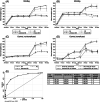A predictive algorithm for identifying children with sickle cell anemia among children admitted to hospital with severe anemia in Africa
- PMID: 35147242
- PMCID: PMC7612591
- DOI: 10.1002/ajh.26492
A predictive algorithm for identifying children with sickle cell anemia among children admitted to hospital with severe anemia in Africa
Abstract
Sickle cell anemia (SCA) is common in sub-Saharan Africa where approximately 1% of births are affected. Severe anemia is a common cause for hospital admission within the region yet few studies have investigated the contribution made by SCA. The Transfusion and Treatment of severe anemia in African Children Trial (ISRCTN84086586) investigated various treatment strategies in 3983 children admitted with severe anemia (hemoglobin < 6.0 g/dl) based on two severity strata to four hospitals in Africa (three Uganda and one Malawi). Children with known-SCA were excluded from the uncomplicated stratum and capped at 25% in the complicated stratum. All participants were genotyped for SCA at trial completion. SCA was rare in Malawi (six patients overall), so here we focus on the participants recruited in Uganda. We present baseline characteristics by SCA status and propose an algorithm for identifying children with unknown-SCA. Overall, 430 (12%) and 608 (17%) of the 3483 Ugandan participants had known- or unknown-SCA, respectively. Children with SCA were less likely to be malaria-positive and more likely to have an affected sibling, have gross splenomegaly, or to have received a previous blood transfusion. Most outcomes, including mortality and readmission, were better in children with either known or unknown-SCA than non-SCA children. A simple algorithm based on seven admission criteria detected 73% of all children with unknown-SCA with a number needed to test to identify one new SCA case of only two. Our proposed algorithm offers an efficient and cost-effective approach to identifying children with unknown-SCA among all children admitted with severe anemia to African hospitals where screening is not widely available.
© 2022 The Authors. American Journal of Hematology published by Wiley Periodicals LLC.
Conflict of interest statement
The authors declare no conflicts of interest.
Figures

References
-
- Kassebaum NJ, Collaborators GBDA. The global burden of anemia. Hematol Oncol Clin North Am. 2016;30(2):247‐308. - PubMed
Publication types
MeSH terms
Grants and funding
LinkOut - more resources
Full Text Sources
Medical
